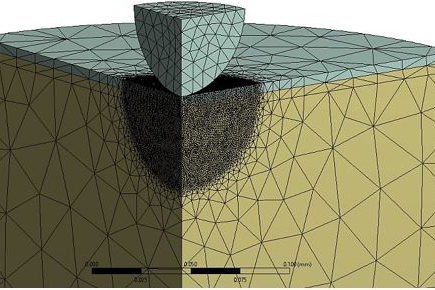Modeling Software Improves Understanding of Porous Coatings
University of Illinois at Chicago leverages SwiftComp software to predict elastic and mechanical properties of porous coatings under different loading conditions.

Coating/substrate structure under a nanoindentation tip to measure the mechanical response of the component. Photo Credit: AnalySwift LLC
AnalySwift, LLC (West Lafayette, Ind.), a provider of efficient high-fidelity modeling software for composites, has announced that University of Illinois at Chicago (UIC) is participating in its Academic Partner Program (APP), and it is using its SwiftComp simulation software for researching new porous coatings for use in manufacturing. The APP offers participating universities no-cost licenses of engineering software programs SwiftComp and VABS so students, researchers, and faculty can leverage the tools in their academic research.
The SwiftComp program is a general-purpose, truly multiscale modeling code for composites and other heterogenous materials. It links detailed microstructure and structural behavior for composite structures including beams, plates/shells, and 3D structures. Broad applications include high strain composites in deployable space structures, printed circuit boards (PCBs), high-end fishing rods, honeycomb sandwich structures, and many others. In this instance the software was used to analyze the performance of Zirconia-Silica conversion coatings.
“We used the Mechanics of Structure Genome concept, implemented in SwiftComp, to calculate the effective elastic and mechanical properties of porous coatings under different loading conditions,” said Dr. Arash Samaei, researcher at the UIC Accelerated Materials Research Lab (AMRL). “The test case for our study was Zirconia- Silica bilayer coating on aluminum alloy. The simulation results enabled us to understand the effects of porosity level on the strength of the macroscale structure. The local stress, strain fields helped us to study the failure mechanisms in such coatings under nanoindentation tips. SwiftComp allowed us to determine the effective properties of the materials that enabled us to accurately simulate the mechanical response of the components.”
“In general, Zirconia-Silica conversion coatings are considered as a potential alternative to Chromium-based conversion coatings, which are fabricated with toxic chemicals,” continued Dr. Samaei. “Not only can zirconia-silica-based conversion coatings provide excellent corrosion protection for metals and alloys used in aerospace applications, but they can also be manufactured using non-toxic chemicals via a plasma-based deposition process.”
Related Content
-
An Overview of Electroless Nickel Plating
By definition, electroless plating is metal deposition by a controlled chemical reaction.
-
How to Choose Between Sulfate and Chloride-Based Trivalent Chromium
There are several factors to consider when choosing between sulfate and chloride-based baths for trivalent chromium plating. Mark Schario of Columbia Chemical discusses the differences and what platers should keep in mind when evaluating options.
-
Top Reasons to Switch to a Better Cleaning Fluid
Venesia Hurtubise from MicroCare says switching to the new modern cleaning fluids will have a positive impact on your cleaning process.









.jpg;maxWidth=300;quality=90)



